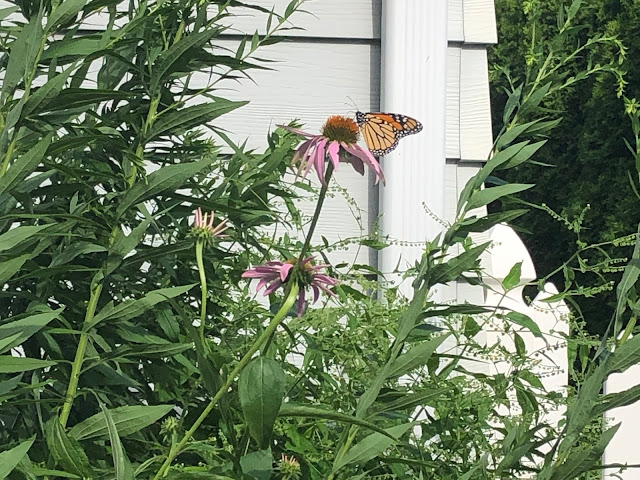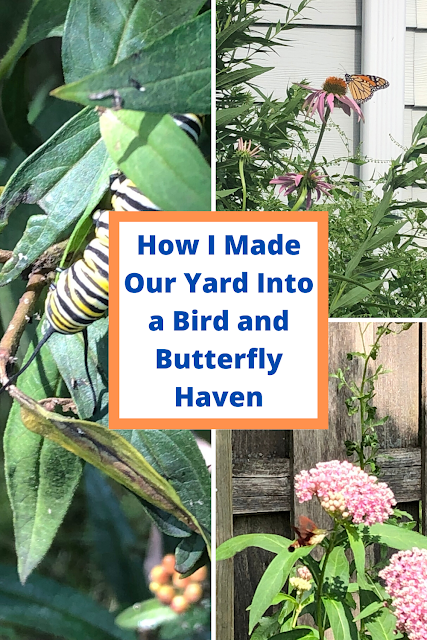 |
| Hummingbird moth enjoying a swamp milkweed in my yard. |
Times are a bit tough right now but we do have lovely spring flowers to look forward to! Those who have been following for awhile, know that I love nature. So, it will not surprise you to learn that my yard has become a haven for birds and butterflies! In fact, I was delighted by about 100 monarch caterpillars throughout last summer. This is a great time to think gardens, so I would like to share what has worked for me!
- Plant natives: Planting plants native to your region provide the best way to attract and support native wildlife. Where I live in Illinois, swamp milkweed, butterflyweed, coneflowers, catmint, dogwood, prairie blazing star, aster, wild bergamot, spiderwort, goldenrod and much more are native and make great choices for the garden. I found a good list of local native plants for me with the City of Chicago Native Plant List.
- Plant dill: We learned how essential dill is to swallowtail butterflies totally by accident. Dill grew rampant in one of my neglected gardens. I was about to pull some until I noticed caterpillars that I identified as swallowtails. So, don't get frustrated with dill! Swallowtail butterflies need it! Dill is an annual. However, if you let it seed it most likely will pop up the next year. Plus, you can save some by freezing it in cubes to use all year! If you do need to pull some, check to make sure you do not see eggs or caterpillars on it first.
- Leave the dandelions: Dandelions are not only important for our bee population but I learned last year that house finches love them! I had one that would visit, sit in the grass and pick out the seeds.
 |
| A monarch enjoying a coneflower in my native garden. |
- Leave the seeds for the birds: The tendency is to remove the dead heads from coneflowers, etc. However, birds will come from the seeds. Goldfinches in particular love the seeds!
- Plant flowers to flower throughout the seasons: If you have a variety of plants flowering and seeding throughout the growing season, you will attract wildlife through a wide swath of the year.
- Have a water source: Having a bird bath is great for attracting birds. Additionally, it is important to keep the water fluid in winter when water is scarce. You can use a heated bird bath or a warmer to do this.
- Have cover at different spots in the yard such as trees and shrubs: Animals need spots to scurry away from predators. So, a variety of cover throughout the yard helps. It also helpful for those little fledglings.
- Know where the plants should go: Pay attention to the light and moisture needs of your plants. I have definitely made the mistake of planting a plant in a spot that is not suitable for it. It is important for its long term survivability of your plants. I plant perennial natives, so I really want them to stick around for awhile!
- Observe: Observe how nature responds to your gardens. This way, you will have an idea of what you can do. For example, it will help you learn what you should dead head and what you shouldn't.
- Observations I have made: Monarchs need swamp milkweed and or butterfly weed. Hummingbirds love hostas and I was surprised last year to see them in the swamp milkweed. Goldfinches like thistle seeds and coneflower seeds. House finches like dandelion seeds. Swallowtails love dill. Not native, but birds love tomatoes so I plant double the amount of plants I think we need to out produce what they take.
More Ideas!
What have you learned while gardening? Share some of what has worked for you and I will add it here!
- My friend April from Minivan Adventures suggests planting Zinnias to attract hummingbirds!


This is great! When would you suggest starting?
ReplyDeleteI would start planning now. There are a lot of native plants sales in the area. The organizations are either taking orders now or will be soon. This year, the ones that are still having a sale will do a curbside pick up. Usually, the plants are distributed in May which is when you would plant. Some plants like asters you will also see in the fall and plant then. I highly recommend asters because monarchs need them for nourishment before flying south.
DeleteThese are such great tips! My mom is always trying to bring new wildlife to her yard, so I will definitely be sharing this with her!
ReplyDeleteIt is so fun! I am always surprised how much I learn just by watching. We used to pull all of our milk thistle until I saw a goldfinch pulling seeds.
DeleteHummingbirds use dandelion fluff to line their nests! Yet another reason to leave your dandelions alone.
ReplyDeleteGood to know! Thank you so much for adding this tip!
Delete